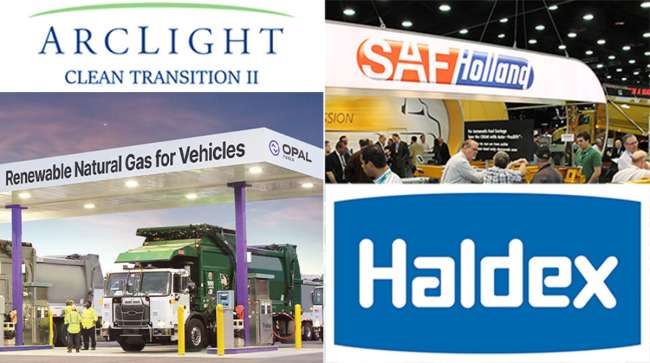Senior Reporter
Deals for Opal Fuels, Haldex Near Closure

[Stay on top of transportation news: Get TTNews in your inbox.]
A producer and distributor of renewable natural gas and a supplier of chassis-related systems and components for trailers, trucks and buses are separately planning for major expansions — one by going public and the other through consolidation.
Both efforts are to approach the finish line in July.
Publicly traded ArcLight Clean Transition Corp. II reminded shareholders to vote July 15 in favor of the proposed business combination with Opal Fuels, a vertically integrated producer and distributor of renewable natural gas and a Fortistar company.
The deal was announced in 2021, and both companies’ boards approved the transaction.
The business combination has an enterprise value of $1.75 billion. It is expected to provide gross proceeds of approximately $536 million to fund the construction of Opal Fuels’ RNG development pipeline.
Those funds include:
- ArcLight’s $311 million of cash held in trust, assuming no redemptions.
- A $125 million fully committed PIPE, anchored by NextEra Energy, Electron Capital Partners, Gunvor Group, Wellington Management and Adage Capital Management.
- Up to a $100 million preferred equity investment from affiliates of NextEra Energy.
Opal Fuels’ vertically integrated model differentiates it from other players in the industry, ArcLight CEO Jake Erhard, said in a release. “That, together with the platform’s more than two decades of experience, gives us tremendous confidence in the company’s ability to execute its growth plans.”
Those growth plans include building 23 more RNG projects from opportunities that are substantially under the company’s control, Jonathan Maurer, co-CEO at Opal Fuels, said in a call with investors in December.

Maurer
“Many of these RNG projects will come from converting our renewable power projects to RNG and some will come from dairy projects that are substantially under our control today,” he said. “Right now, seven of these projects are under construction, with another 16 in the advanced development and execution phase.”
Maurer during the call highlighted the company’s focus on renewable hydrogen, including with BayoTech, is an on-site hydrogen production and ‘gas-as-a-service’ company.
“We have commenced engineering and site acquisition to build several hydrogen fueling stations for BayoTech next year (2022),” he said. “In addition, we will provide RNG to lower the carbon intensity of their hydrogen fuel production.”
Also, Opal Fuels and truck maker Nikola Corp. have an memorandum of understanding to co-develop and construct hydrogen fueling stations and related infrastructure, Maurer said. “We will also provide RNG to Nikola’s hydrogen production partner. Lastly, we have a strategic relationship with CarbonFree to develop carbon capture facilities at several of our RNG facilities.”
The combined company will be listed on the Nasdaq Exchange under the ticker symbol “OPAL.”
SAF Holland’s bid to acquire Haldex, whose board unanimously approved the step, is in the acceptance period as Haldex shareholders consider the approximately $300 million offer — which is the latest, and likely, last one in a chain of various parties’ interest in acquiring Haldex reaching back to 2016.
The offer price represents a premium of approximately 46.5% to the closing price of the Haldex shares on Nasdaq Stockholm on the day before the announcement of the offer.
The acceptance period of SAF’s offer was scheduled to begin in July and expire Aug. 16, subject to any extensions.
Over the past several years several companies unsuccessfully pursued Haldex. SAF, in its first effort in 2016, attempted to acquire it. So did ZF Friedrichshafen AG and Knorr-Bremse AG.
The battle over Haldex is part of a broader push by parts makers to combine to share development costs amid an industry shift toward self-driving and electric vehicle technologies, Bloomberg News reported in 2016 — shifts that have only intensified since then.
One analyst of original equipment and aftermarket trends said SAF’s proposed acquisition of Haldex announced in June made absolute sense.

3PL problem-solvers discuss the supply chain and how they use technology to improve their customer competitiveness. Tune in above or by going to RoadSigns.TTNews.com.
“They have synergies on the backend that they can share and save funds,” John Blodgett, vice president at MacKay & Co., a research and management consulting firm, told Transport Topics. “They can go to vehicle manufacturers with a more complete package and offering. I think that’s attractive both for their customers, from their own standpoint.”
The Haldex board noted the company has seen major competitors consolidate and this poses risks to the company and its ability to realize the full potential of its growth prospects. The combination with SAF would be “highly complementary from a regional presence and product portfolio perspective, will establish a strong global player in the commercial vehicle industry.”
Haldex’s corporate evolution reaches back to a clockmaking company in 1887. In 1916 it filed a patent for an automatic brake adjuster, which by the 1960s was targeted at road vehicles. Today, its market includes braking systems and air suspension systems for heavy trucks, trailers and buses. It has 2,000 employees across four continents.
Want more news? Listen to today's daily briefing below or go here for more info:

